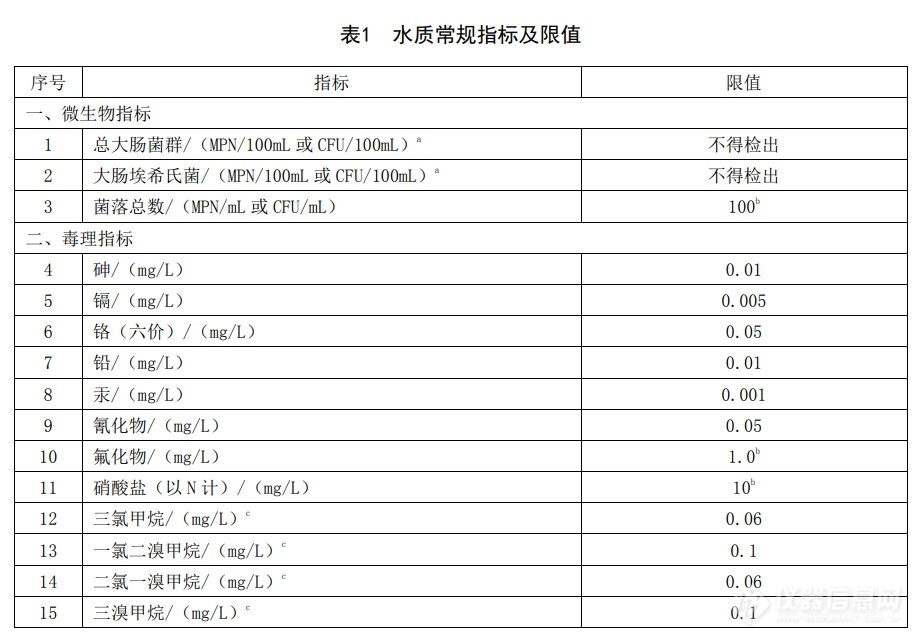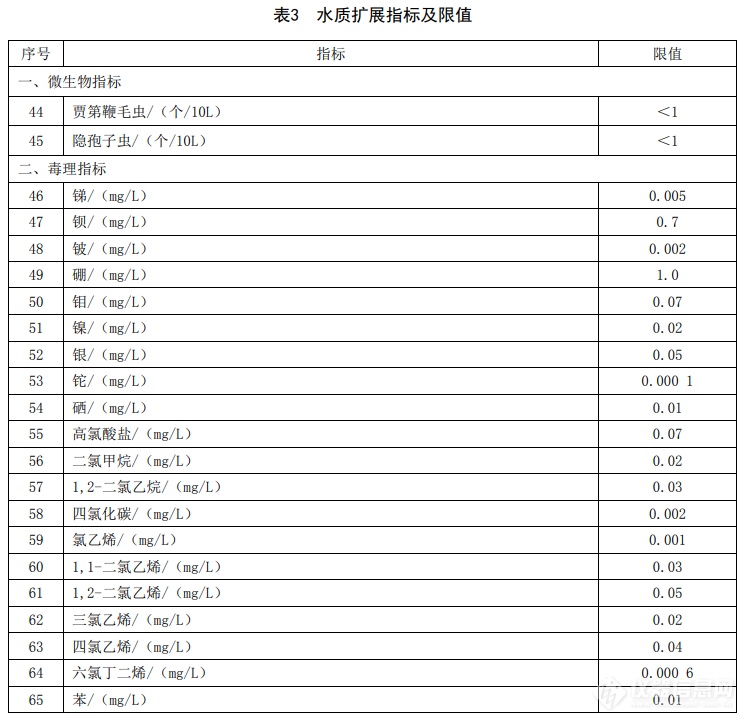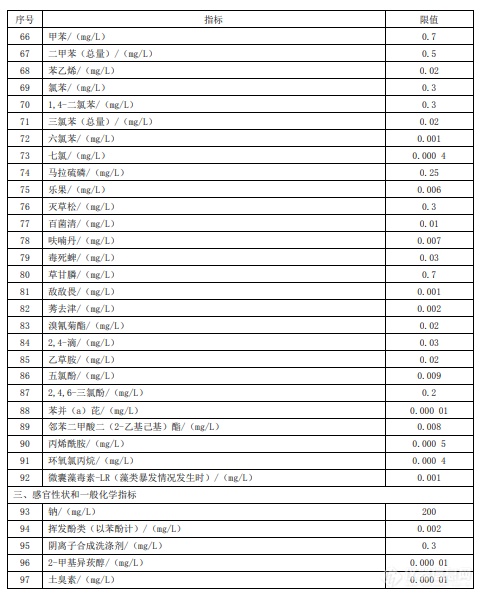A few days ago, the State Administration for Market Regulation and the National Standardization Administration approved the release of the "Sanitation Standards for Drinking Water" GB 5749-2022, which will be implemented on April 1, 2023.
The current GB 5749-2006 "Sanitary Standards for Drinking Water" was jointly issued by the former Ministry of Health and the National Standards Committee in December 2006 , and has been implemented since July 1 , 2007 . In the application in recent years, some problems are gradually reflected. Therefore, from March 2018 to the present, the National Health Commission and relevant ministries have carried out a new round of standard revision work.
This revision of the standard makes a clearer description of the scope of the standard, updates the normative reference documents, and changes the terms and conditions of centralized water supply, small centralized water supply, secondary water supply, factory water, peripheral water, conventional indicators and extended indicators The definition is revised and improved or added or deleted, and editorial changes are made to the text in some clauses of the full text. On this basis, compared with GB 5749-2006 , the main revisions are as follows:
1. Adjustment of the number of indicators
The water quality indicators in the standard text have been adjusted from 106 items in GB 5749-2006 to 97 items, and the revised text includes 43 regular indicators and 54 extended indicators. Among them, 4 indicators were added, including perchlorate, acetochlor, 2 -methylisocamphenol, and geosmin; 13 indicators were deleted, including heat-resistant coliforms, chloral, sulfide, chlorinated Cyanide (as CN- ), hexahexahexanol (total), parathion, methyl parathion, lindane, DDT, formaldehyde, 1,1,1- trichloroethane, 1,2 -dichlorobenzene and ethylbenzene.
2. Adjustment of the index classification method
According to the characteristics of water quality indicators, the index classification method is adjusted from “ conventional indicators and unconventional indicators ” in GB 5749-2006 to “ regular indicators and extended indicators ” . Among them, conventional indicators refer to water quality indicators that reflect the basic status of drinking water quality; extended indicators refer to indicators that reflect the characteristics of regional drinking water quality and the water quality status within a certain period of time or under special circumstances.
3. Adjustment of index limits
According to the monitoring significance of water quality indicators and the latest research results in population health effects or toxicology, combined with the actual situation in China, the limits of 8 indicators have been adjusted, including nitrate (in terms of N ), turbidity, permanganic acid Salt Index (as O2 ), Free Chlorine, Boron, Vinyl Chloride, Trichloroethylene and Dimethoate.
4. Adjustment of indicator names
According to the meaning expressed by the water quality indicators, the names of two indicators were adjusted, including oxygen consumption ( CODMn method, measured by O 2 ) and ammonia nitrogen (measured by N ).
5. Adjustment of index classification
According to the monitoring significance, detection situation and concentration level of water quality indicators, the classification of 11 indicators has been adjusted, including chlorodibromomethane, Chlorobromomethane, sum of bromomethane), dichloroacetic acid, trichloroacetic acid, ammonia (as N ), selenium, carbon tetrachloride, volatile phenols (as phenol) and anionic synthetic detergents.
6. Added the requirement of deducting 40K and the application of microcystin- LR index of total β radioactivity index before nuclide analysis and evaluation. Potassium is an essential element for human body, and total β radioactivity measurement includes potassium- 40 . Based on the consideration that the potassium- 40 screening level should be excluded when evaluating the comprehensive carcinogenic risk of total β- radioactive indicators, this revision clarifies that the total β- radioactivity after deducting potassium- 40 is still greater than 1 Bq/L , and nuclide analysis and evaluation should be carried out to determine Can drink.
There is 31.2 Bq/g of potassium- 40 per gram of natural potassium, which can be used to calculate the contribution of potassium- 40 to the total beta activity concentration. Based on the consideration that the risk of exposure to Microcystin- LR is only possible in the event of an algal bloom, this revision adjusts the expression of Microcystin- LR to Microcystin- LR (in the event of an algal bloom). ) to make the presentation more specific.
7. Delete the temporary regulations on water quality indicators and limits for small centralized water supply and decentralized water supply. Considering the current situation of drinking water quality in urban and rural areas in China, this revision deletes Table 4 in GB 5749-2006 " Small centralized water supply and Transitional requirements for water quality indicators and limits for decentralized water supply. At the same time, considering the current status of small centralized water supply and decentralized water supply in China, due to the limitation of water source and water purification technology, transitional requirements are reserved for the total number of bacterial colonies, fluoride, nitrate (in terms of N ) and turbidity .
8. Improve the requirements for the water quality of drinking water sources In view of the fact that the water quality of drinking water sources cannot meet the requirements of the corresponding national standards for the time being, but is limited by conditions and must be used, this revision improves the water quality requirements for drinking water sources. , it is proposed that when the water quality of the water source cannot meet the corresponding requirements, but " it needs to be used due to limited conditions, the corresponding purification process should be used for treatment, and the treated water quality should meet the requirements of this document "
9. Delete content related to drinking water management
In view of the fact that it is not appropriate to put forward administrative requirements in the technical standards, the relevant requirements are deleted in this revision, and the relevant content of " water quality monitoring " in GB 5749-2006 is also deleted.
10. Adjustment of water quality reference indicators in Appendix A Appendix A (informative) Water quality reference indicators are adjusted from 28 items in GB 5749-2006 to 55 items. Among them, 29 new indicators have been added, including vanadium, hexahexahexanol (total), parathion, methyl parathion, lindane, DDT, trichlorfon, thiophanate-methyl, rice blast, trifluralin , Metalaxyl, Xicaojing, Acephate, Formaldehyde, Trichloroacetaldehyde, Cyanogen Chloride (calculated as CN- ), Nitrosodimethylamine, Iodoacetic Acid, 1,1,1- Trichloroethyl alkane, ethylbenzene, 1,2 -dichlorobenzene, perfluorooctanoic acid, perfluorooctanesulfonic acid, dimethyl disulfide, dimethyl trisulfide, iodide, sulfide, uranium and radium -226 ; deleted 2 indicators, including 2- methyl isocamphenol and geosmin; revised the names of 2 indicators, including dibromoethylene and nitrite; adjusted the limit of 1 indicator, petroleum ( total).





![]() GB5749 Hygienic Standard for Drinking Water (Draft for Approval).pdf
GB5749 Hygienic Standard for Drinking Water (Draft for Approval).pdf
![]() Instructions for the preparation of sanitary standards for drinking water.pdf
Instructions for the preparation of sanitary standards for drinking water.pdf
related suggestion

- ·【industry news】
A quick overview of the full t
- ·【industry news】
The National Health and Health
- ·【industry news】
5 water quality testing standa
- ·【industry news】
Catalogue of National Food Saf
- ·【industry news】
my country has initially estab
share to:
keywords: the new laboratory analytical instruments, intelligent pre-processing equipment